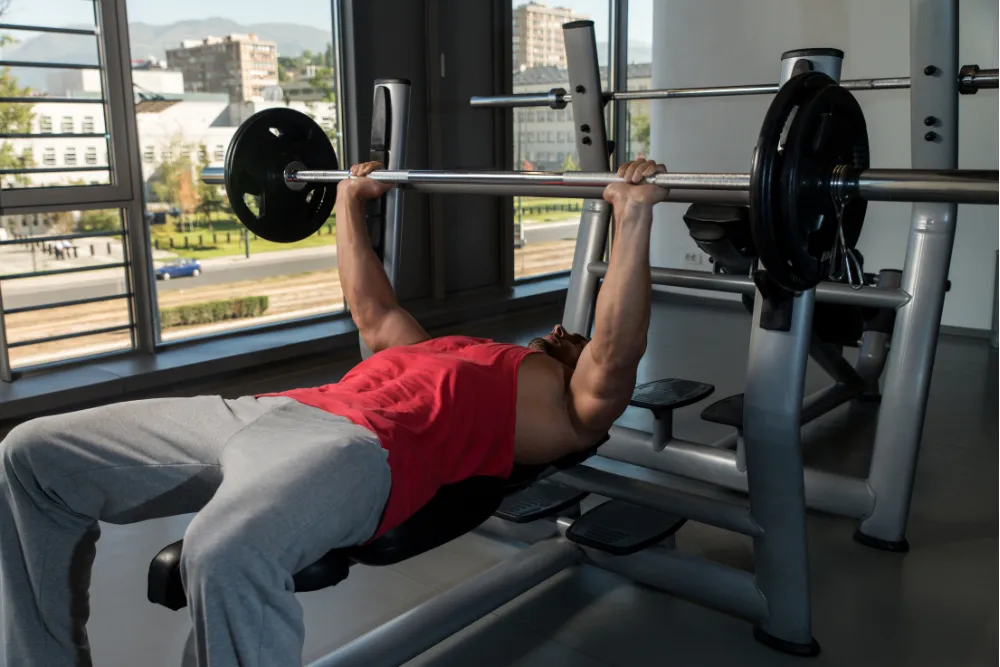There’s nothing quite as frustrating as gearing up for chest day—bench press loaded, warm-up done—only to feel that nagging shoulder pain flare up mid-rep. It might start as a dull ache or a subtle click. But before you know it, you’re avoiding the bar altogether.
Sound familiar?
You’re not alone. Shoulder pain during chest exercises is common but very treatable once we understand the root cause. In our clinical practice, we’ve treated hundreds of recreational lifters and athletes with similar patterns. Most often, we find that the issue lies not in the painful area, but in how the body is moving as a whole.
This post will break down the why, the what, and the how. So you can get back to pain-free training safely and confidently.
Why Does My Shoulder Hurt When I Work Out My Chest?
The shoulder is an incredibly mobile joint, capable of complex movement patterns. But that mobility comes at a cost: stability. To press heavy or even moderately loaded weights safely, your shoulder joint relies on a synchronized team of muscles and stabilizers working behind the scenes.
If even one part of that chain is off (poor technique, weak scapular control, tight pecs), you’ll feel it, often in the form of pain, pinching, or fatigue in the shoulder.
Common Causes of Shoulder Pain During Chest Exercises
Here’s what we frequently see in clinical assessments:
1. Poor Scapular Mechanics
Your shoulder blade (scapula) is the foundation of your shoulder joint. If it’s not rotating or stabilizing properly during pressing movements, your rotator cuff ends up doing double the work leading to irritation or overuse.
2. Overactive Front Delts, Underactive Stabilizers
Many people overuse their anterior deltoids (front shoulder muscles) during pressing. If muscles like the serratus anterior, lower traps, or rotator cuff aren’t pulling their weight, you’re pressing with poor support.
3. Chest Dominance + Rounded Posture
Modern life promotes a forward, hunched posture. Add to that excessive pressing volume without balancing pulling movements, and you have a recipe for shoulder compression and impingement.
4. Technique Errors
- Flaring elbows too wide (placing stress on the joint capsule)
- Going too deep on bench press with poor shoulder mobility
- Improper grip width increasing stress on the AC joint
These might not cause immediate injury but repeated over time, they contribute to pain and dysfunction.
“Where It Hurts” Matters – A Physio’s Guide to Pain Patterns
The location and type of pain tell us a lot about what’s going wrong:
| Pain Location | Likely Issue |
|---|---|
| Front of shoulder | Biceps tendon irritation or impingement |
| Side of shoulder | Rotator cuff overload |
| Deep in the joint | Labral stress or instability |
| Pain with barbell but not dumbbells | Joint positioning issue or grip mechanics |
Knowing where it hurts helps us tailor treatment and recovery strategies.
Biomechanics: Why Chest Exercises Stress the Shoulder
During movements like bench press or push-ups, your humerus (upper arm bone) needs to glide smoothly in the socket while being stabilized by deep muscles. However, poor thoracic mobility, lack of scapular retraction, or faulty motor patterns can disrupt this balance.
Key biomechanical stressors:
- Flaring the elbows out >60° from the body increases anterior joint stress.
- Not retracting scapulae on bench press leads to poor joint centration.
- Pressing with a flat or stiff thoracic spine changes shoulder positioning and increases compensation.
What a Physiotherapist Assesses
Shoulder pain assessments go far beyond checking form. We evaluate:
- Thoracic spine mobility
- Scapular control during dynamic movement
- Pec minor and lat tightness
- Rotator cuff strength ratios
- Nerve tension or signs of referral pain
We often find that the root cause of pain isn’t always located where the symptoms appear. For example, tight hips can affect core stability, which in turn subtly but significantly alters upper body mechanics.
“The shoulder is rarely the true culprit. It’s usually the victim of poor movement somewhere else.”
Common Mistakes People Make (and How to Fix Them)
| Mistake | What To Do Instead |
|---|---|
| Powering through the pain | Listen to early warning signs and modify movements |
| Only stretching the area | Strengthen supporting muscles, not just stretch |
| Avoiding all pressing | Modify angles (e.g., floor press or incline) instead of total rest |
How Physiotherapy Helps You Recover and Come Back Stronger
Physiotherapy is more than rehab exercises. We combine:
- Manual therapy to release restrictions in the pecs, neck, or scapula
- Dry needling or cupping to reduce local muscular tension
- Corrective exercises for motor control, not just brute strength
- Movement retraining under load, with guided progression back to pressing
We also teach patients how to manage volume, warm-up protocols, and implement recovery strategies—so the pain doesn’t return.
When Should You See a Physiotherapist?
Don’t wait until you’re forced to stop training. Seek help if:
- Pain lingers >2 weeks
- There’s weakness or instability
- You feel clicking or locking
- Pain is affecting sleep or daily function
Early intervention often means faster recovery and less time off training.
Takeaway: Train Smart, Stay Pain-Free
Shoulder pain during chest workouts isn’t a sign you’re weak, it’s a sign your body is asking for better mechanics, support, and recovery. The earlier you act, the better your results.
A thorough physiotherapy assessment can uncover hidden causes and help you return to training safely and confidently.
Need help figuring out what’s causing your pain? Book an expert evaluation and take the guesswork out of recovery.

Amit Saraswat is the Founder of Physioveda Medical Center, a Dubai-based clinic focused on personalized physiotherapy and integrative healthcare. With a passion for patient-centric solutions, he leads the vision behind Physioveda’s evidence-based approach to pain relief and long-term recovery.

